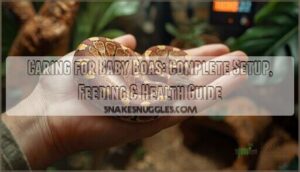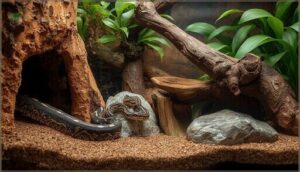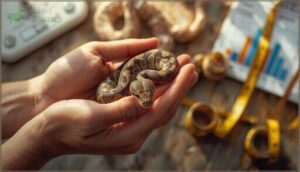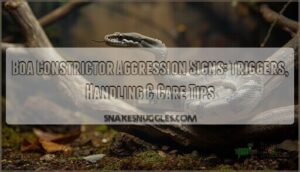This site is supported by our readers. We may earn a commission, at no cost to you, if you purchase through links.

A baby boa coiled around your hand for the first time is a moment you won’t forget. That smooth muscle wrapping gently around your fingers carries both wonder and responsibility. These snakes can live thirty years or more in captivity, which means the decisions you make in those first weeks shape decades of health and wellbeing.
Getting the fundamentals right from day one prevents common pitfalls that send new keepers back to the pet store in panic or to the vet clinic with preventable problems. Caring for baby boas becomes straightforward once you understand their specific needs for temperature, humidity, feeding schedules, and environmental security.
Table Of Contents
Key Takeaways
- Baby boas require a thermal gradient of 75-95°F with distinct basking and cool zones, plus humidity between 55-75% (increasing to 75-85% during sheds) to support proper digestion, immune function, and successful shedding throughout their 30+ year lifespan.
- Feed appropriately sized rodents every 7-10 days for neonates, matching prey width to the snake’s mid-body girth, and adjust both prey size and feeding frequency as the boa matures to prevent obesity while supporting healthy growth.
- Start with short handling sessions using gentle support for the entire body, and conduct weekly visual inspections plus monthly weight checks to catch stress signals, respiratory infections, or shedding problems before they become serious health issues.
- Never house baby boas together due to cannibalism risks and stress, and plan for enclosure upgrades when the snake’s length approaches the sum of the floor dimensions since juvenile boas grow rapidly in their first two years.
Choosing and Preparing a Baby Boa
Bringing home a baby boa starts with making smart decisions before you even set up the enclosure. You need to know what a healthy snake looks like, understand the different species and color morphs available, and gather all the right supplies from day one.
These three steps form the foundation of responsible boa ownership and help you avoid common beginner mistakes.
Selecting a Healthy Baby Boa
When choosing a healthy baby boa constrictor, look for clear eyes, clean nostrils, and smooth scales without lumps or wounds. A well-conditioned baby boa feels firm and muscular with a square-shaped body.
Assess behavioral cues like alertness and tongue flicking during handling. Request breeder information on feeding history and disease screening results to avoid transport stress later.
Seek veterinary care if uncertain about your selection. Chronic regurgitation can be a sign of Inclusion Body Disease.
Understanding Boa Constrictor Species and Morphs
Once you’ve identified a healthy individual, understanding boa constrictor species and their color morphs helps you anticipate adult size and care needs. Colombian boas generally reach six to nine feet, while true Red-Tails exceed twelve feet.
Captive breeding has produced numerous color mutations—albino, hypomelanistic, and anerythristic morphs—each displaying unique physical characteristics. Market trends show albino and designer combinations commanding premium prices.
Species identification and morph genetic traits guide husbandry decisions and long-term planning. These snakes are native to Central and South America.
Essential Supplies Checklist
After selecting your baby boa constrictor, gather supplies before bringing it home. You’ll need a secure enclosure with substrate options like aspen shavings, heating equipment including thermostats and heat lamps, and monitoring tools like digital thermometers and hygrometers to maintain proper temperature gradient and humidity levels.
Stock these essentials:
- Feeding tools such as long forceps for safe prey delivery
- Cleaning supplies including reptile-safe disinfectants
- Safety accessories like secure lid fasteners and handling hooks
Setting Up a Safe Boa Enclosure
Your baby boa’s enclosure isn’t just a container. It’s the foundation of their health and security for years to come. Let’s walk through the key elements you need to get right from day one.
Your baby boa’s enclosure is the foundation of their health and security for years to come
Minimum Enclosure Size for Baby Boas
Your baby boa constrictor needs room to stretch and thermoregulate. The enclosure dimensions depend on boa length. A baby under 2 feet requires a 2-foot-long reptile enclosure. Juveniles between 2 to 5 feet need approximately 4 feet long by 2 feet wide. Growth considerations matter since boas can triple in size within their first year.
| Boa Length | Enclosure Dimensions (L × W × H) | Growth Considerations |
|---|---|---|
| Under 2 feet | 2 ft × 1.5 ft × 1 ft | Rapid growth in first year |
| 2–5 feet (juvenile) | 4 ft × 2 ft × 2 ft | Multiple hides reduce stress |
| 6–8 feet (adult) | 6 ft × 3 ft × 3 ft | Semi-arboreal behavior supported |
| Material choices | PVC, glass, or plastic tubs | Environmental control varies |
| Expert recommendations | Length + width ≥ snake length | Spatial needs for thermoregulation |
Secure Enclosure Design and Ventilation
Your reptile enclosure needs escape-proof lids with at least four secure clamps on glass tanks. Front-opening designs reduce stress compared to top-access enclosures.
Position 6 to 12 square inches of total ventilation near the top and bottom for airflow without losing humidity.
Use PVC or sealed wood with VOC-free finishes. Avoid tape on lids since residue injures baby boa constrictors.
Substrate Options and Cleaning Tips
You can maintain humidity retention and support burrowing behavior with coconut fiber or a DIY mix of 40% topsoil, 40% reptile soil, and 20% sand. Cypress mulch holds moisture well but needs mold prevention monitoring.
Avoid aspen wood shavings in humid setups and fine particles that risk substrate impaction. Bioactive benefits include natural waste breakdown.
Spot clean daily and replace substrate every 3-4 months.
Providing Hides and Environmental Enrichment
Your baby boa needs at least two hiding places to reduce stress by 30%. Cork bark and caves work well as hide materials on the ground, while branches with partial cover create arboreal enrichment for climbing.
Environmental enrichment increases natural behaviors and promotes overall welfare in captive snakes. Rotate reptile enrichment every 1-2 weeks to maintain exploration and prevent boredom.
| Enrichment Type | Examples |
|---|---|
| Hiding area options | Cork bark, caves, foliage |
| Climbing structures | Branches with partial cover |
| Object-based items | Tubes, paper rolls, rocks |
| Rotating schedule | Every 7-10 days |
| Information sources | Experienced keepers, journals |
Creating Ideal Temperature and Humidity
Your baby boa’s health depends on getting the temperature and humidity just right. These aren’t small details you can guess at—they’re the foundation of proper thermoregulation and successful shedding.
Let’s break down how to create and maintain the environmental conditions your boa needs to thrive.
Establishing a Proper Temperature Gradient
Your baby boa depends on a proper temperature gradient to digest food and maintain immune function. Position heat sources on one end of the enclosure to establish thermal zones spanning 75–95°F.
Use thermostat-controlled ceramic heat emitters or radiant heat panels for reliable heating requirements. Monitor both surface and air temperatures with infrared guns and digital thermometers.
Your boa’s positioning within the gradient tells you if thermal equipment meets its physiological needs.
Setting Up Basking and Cool Zones
Your boa can’t adjust its body temperature internally—that’s why you need distinct basking and cool zones. Create these thermal zones with precision to support digestion and immune health:
- Position basking surfaces at 90–95°F using screened heat sources
- Maintain cool zone air temperature at 75–80°F
- Monitor both zones twice daily with infrared thermometers
- Make sure zones occupy separate enclosure ends for proper heat gradient formation
Maintaining Optimal Humidity Levels
Your boa’s shedding process and proper hydration depend on humidity levels between 55–75%. Increase to 75–85% when shedding begins. Use digital hygrometers for humidity monitoring—analog types aren’t reliable.
Place water bowls in warm zones to boost evaporation. Mist enclosures manually or add humid hides with moistened moss.
Remember species variation matters: tropical boas need higher humidity than desert morphs. Low humidity causes shedding problems and dehydration.
Monitoring and Adjusting Environmental Conditions
Setting the right conditions isn’t a one-time task. Check your digital sensors twice daily to catch fluctuations early. Recalibrate thermostats every two weeks for temperature stability. Log readings to spot patterns—seasonal adjustments become obvious when you track data over months.
If your thermal gradient drifts or humidity control falters, incomplete sheds and respiratory trouble follow. Reliable sensor calibration and consistent data logging prevent most environmental health problems.
Feeding and Nutrition for Baby Boas
Getting your baby boa’s diet right sets the foundation for healthy growth and long-term wellbeing. Feeding mistakes are easy to make, but understanding the basics helps you avoid common pitfalls that can affect your snake’s development.
Let’s walk through what you need to know about prey size, feeding schedules, and nutritional needs as your boa matures.
Prey Size and Feeding Frequency
Getting prey sizing right from the start sets your baby boa up for healthy growth. Feed neonates appropriately sized rodents matching their mid-body width every 7-10 days.
Follow these guidelines:
- Offer pinkies (4-9 grams) to new hatchlings
- Switch to hopper mice as your boa grows
- Always thaw frozen rodents completely before feeding
- Avoid overfeeding to prevent obesity and health complications
Nutritional Balance and Supplements
While rodent nutrition covers calories, micronutrient gaps exist in feeder prey. Your baby boa benefits from calcium supplementation and vitamin D3 every 2-4 feedings to prevent metabolic bone disease. Dust prey lightly with reptile multivitamins containing trace minerals.
Dietary variety—alternating mouse and rat—improves nutritional balance without over-supplementation risks. Monitor growth closely and adjust feeding frequency as your boa matures.
Providing Fresh Water and Hydration
Water supply matters just as much as proper nutrition. Place a clean water bowl in your boa’s enclosure and change it daily to prevent bacterial buildup. Monitor for hydration signs like smooth skin and normal shedding. Mist the enclosure regularly to maintain humidity levels between 55-75%. Watch your boa’s soaking behavior—frequent submersion may signal shedding difficulties or dehydration requiring electrolyte baths.
- Clean water bowls with antibacterial soap and rinse thoroughly to remove chemical residues
- Use hygrometers to track humidity levels and adjust misting frequency as needed
- Provide humid hides with damp sphagnum moss to support proper hydration and comfort
Adjusting Diet as Your Boa Grows
As your boa matures, you’ll need to adjust both feeding frequency and prey size to match its changing metabolic rate. Growth influences everything from nutritional needs to diet changes.
Here’s your guide:
| Age Range | Feeding Frequency | Prey Size Guidelines |
|---|---|---|
| 0-2 years | Every 10-14 days | Pinky mice (4-9g) |
| 2-3 years | Every 2 weeks | Small rats (33-180g) |
| 3-5 years | Every 3 weeks | Medium rats (100-180g) |
| 5+ years | Every 4 weeks | Jumbo rats (180-250g+) |
Monitor body condition regularly to prevent obesity while supporting healthy growth and development.
Handling, Health, and Growth Monitoring
Handling your baby boa correctly helps build trust and prevents unnecessary stress. Beyond handling techniques, you need to monitor your snake’s health through regular checks and watch for growth patterns that signal when it’s time for a bigger home.
Knowing what’s normal and when to call a vet keeps your boa healthy throughout its development.
Gentle Handling Techniques for Baby Boas
Handling your baby boa requires patience and a gentle touch. Start with short sessions of just a few minutes and support the entire body with both hands during initial contact. Slow movements and calm tones help with stress reduction while building trust through positive experiences.
Wash your hands before and after snake handling for safety measures. Consistent gentle handling creates a more relaxed adult boa over time.
Recognizing Signs of Stress or Illness
Your baby boa’s behavior tells you everything. Stress signals like constant pacing or feeding refusal shouldn’t be ignored. Watch for vocalizations like hissing or physical changes such as lethargy and weight loss.
Abnormal shedding often points to environmental problems. Respiratory infections show up as wheezing or nasal discharge.
Catching these signs early through stress avoidance and regular health checks prevents serious snake health issues down the road.
Routine Health Checks and Shedding Support
Regular health checks protect your boa from hidden threats. Schedule annual veterinary care for parasite detection and fecal examinations. Conduct visual inspections weekly to spot respiratory infections or skin infections early. Weight monitoring monthly catches problems before they escalate.
During shedding frequency peaks—up to nine times yearly in juveniles—boost humidity control to 55-70% and provide a moist hide. Complete sheds in one piece signal proper care.
Tracking Growth and When to Upgrade The Enclosure
Track your boa’s growth rate monthly using weight and length measurements. Juvenile boas grow rapidly in the first two years, requiring enclosure upgrades when they reach lengths approaching the sum of their floor dimensions.
Monitoring growth guides feeding adjustments and prevents enclosure stress factors.
Plan for long-term enclosure dimensions and cost considerations early—frequent upgrades strain budgets and disrupt your snake’s routine.
When to Seek Veterinary Care
Preventative checkups once a year establish a baseline for your boa’s health. Watch for eye abnormalities like cloudiness or discharge, skin lesions such as blisters or lumps, and appetite loss beyond normal shedding periods. Respiratory infections show up as wheezing or labored breathing. Neurological signs like paralysis demand urgent veterinary care.
Common illnesses in boa constrictors progress quickly, so early health checks guarantee signs of a healthy boa snake remain consistent.
Frequently Asked Questions (FAQs)
Can baby boas be housed together safely?
Think of it like forcing strangers into a studio apartment—it rarely ends well. Baby boa constrictors should never share housing due to cannibalism risks, stress indicators, and growth disparity that experts consistently warn against.
How do you transport a baby boa?
Transport your baby boa constrictor in secure containers with air holes.
Maintain temperatures between 75-85°F and minimize handling to avoid stress.
Check legal restrictions before travel and use gentle handling techniques throughout.
What sounds or noises do baby boas make?
Baby boas primarily hiss when threatened or stressed. This defensive vocalization results from air forced through the glottis.
Some also produce low rattling sounds through muscle vibrations, mimicking rattlesnakes without actual rattles.
How often should the enclosure be cleaned?
Spot clean waste daily and replace soiled substrate immediately.
Deep clean your boa’s enclosure every three to six months using reptile-safe disinfectant. This cleaning frequency prevents bacterial infections while reducing stress from over-sanitization.
Do baby boas need UV lighting?
While UVB lighting isn’t strictly required for survival, providing low-level UVB benefits baby boas by supporting D3 synthesis, basking behavior, and natural lighting spectrum closer to wild exposure patterns.
Conclusion
Getting your setup squared away—and your confidence wrapped around the details—sets the foundation for a thriving snake.
Caring for baby boas demands consistency in temperature, humidity, feeding schedules, and vigilant health monitoring. When you honor those needs from the start, you’re not just keeping a pet alive. You’re nurturing a relationship that spans decades.
Your boa will reward that commitment with steady growth, reliable temperament, and the quiet satisfaction of responsible reptile stewardship.
- https://www.knobcreeknaturalist.com/blog/creating-boa-constrictor-habitats
- https://www.cascadekennels.com/red-tail-boa-care/
- https://animaldiversity.org/accounts/Boa_constrictor/
- https://pmc.ncbi.nlm.nih.gov/articles/PMC9602588/
- https://reptifiles.com/boa-constrictor-care/boa-constrictor-enclosure-size/













